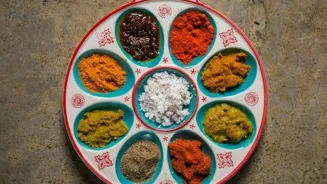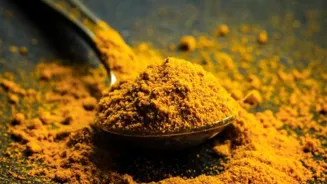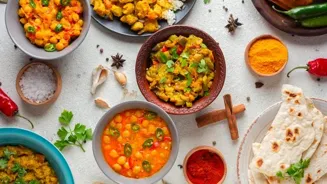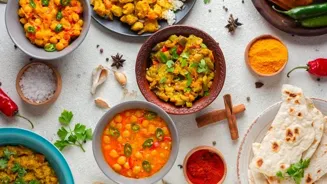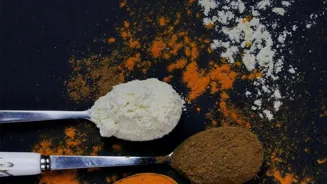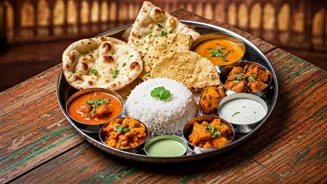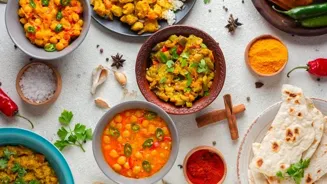Unveil the Mysteries of Indian Spice Blends: Elevate Your Dishes with 10 Vegetarian Recipes. Dive into a world of flavor!
India, the land of vibrant colours and diverse cultures, is equally renowned for
its kaleidoscope of flavours. Central to Indian cuisine are spice blends, carefully curated mixtures that transform simple ingredients into culinary masterpieces.
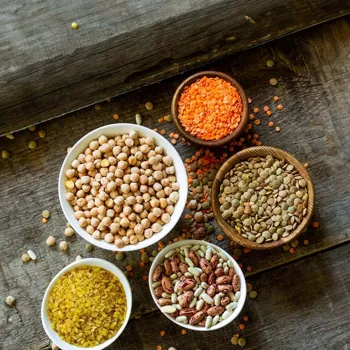
Understanding these crucial components unlocks a world of gastronomic possibilities, allowing you to recreate authentic Indian dishes in your own kitchen. This article delves into the building blocks of iconic Indian spice blends and provides ten vegetarian recipes to ignite your taste buds.
Many folks believe that creating those perfect Indian curries requires years of skill. But the truth is, it's all about understanding the spices and how they work together. Common spices like turmeric, coriander, cumin, and chilli powder form the base of most blends.
Turmeric brings that wonderful golden colour and a slightly earthy flavour, while coriander adds a citrusy and sweet note. Cumin lends a warm, earthy aroma, and chilli powder provides the necessary heat.
Beyond these core ingredients, you'll often find spices like ginger, garlic, cardamom, cloves, cinnamon, and mustard seeds contributing to the complex flavour profiles.
The Foundation of Flavour: Common Indian Spices
Let's take a closer look at some of the superstars in the Indian spice rack:
Turmeric (Haldi): Known for its vibrant yellow colour and earthy flavour, turmeric also boasts anti-inflammatory properties. It's a staple in most Indian dishes.
Coriander (Dhania): Available as seeds or powder, coriander offers a citrusy and slightly sweet flavour. The seeds are often roasted and ground for a more intense taste.
Cumin (Jeera): This earthy and warm spice is commonly used in its whole or ground form.
Roasting cumin seeds before grinding enhances its flavour.
Chilli Powder (Lal Mirch): The heat level varies depending on the type of chilli used, ranging from mild to extremely spicy. Kashmiri chilli powder is known for its vibrant red colour and mild heat.
Ginger (Adrak): Fresh or dried, ginger adds a pungent and slightly spicy flavour. It's often used in pastes, curries, and teas.
Garlic (Lahsun): A vital ingredient in many Indian dishes, garlic offers a pungent and aromatic flavour. It's best used fresh for maximum flavour.
Cardamom (Elaichi): Available in green and black varieties, cardamom adds a sweet and aromatic flavour. Green cardamom is more commonly used in sweet dishes, while black cardamom has a smoky flavour and is used in savoury dishes.
Cloves (Laung): These dried flower buds offer a strong and pungent flavour. Use sparingly, as they can easily overpower other spices.
Cinnamon (Dalchini): Available as sticks or powder, cinnamon adds a warm and sweet flavour. It's often used in both sweet and savoury dishes.
Mustard Seeds (Rai): Black or yellow mustard seeds are typically tempered in hot oil to release their nutty and pungent flavour.
Crafting Your Own Spice Blends: A Step-by-Step Guide
Making your own spice blends is not only easy but also allows you to customize the flavours to your liking. Here's a simple guide:
Gather Your Spices: Start with high-quality, whole spices if possible.
Roast (Optional): Roasting whole spices enhances their flavour and aroma. Dry roast them in a pan over medium heat for a few minutes until fragrant. Be careful not to burn them.
Grind: Use a spice grinder or a mortar and pestle to grind the spices into a fine powder.
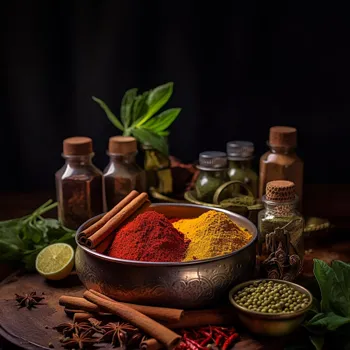
Combine: Mix the ground spices according to your desired recipe.
Store: Store the spice blend in an airtight container in a cool, dark place. It will stay fresh for several months.
10 Vegetarian Spice Blend Recipes to Elevate Your Cooking
Here are ten vegetarian spice blend recipes to get you started:
Garam Masala: This is a cornerstone of Indian cuisine, adding warmth and complexity to curries and stews. Combine 2 tablespoons coriander seeds, 1 tablespoon cumin seeds, 1 tablespoon cardamom pods, 1 tablespoon cloves, 1 cinnamon stick, and 1 teaspoon black peppercorns. Roast, grind, and store.
Sambar Masala: Essential for the South Indian lentil and vegetable stew, Sambar.
Mix 4 tablespoons coriander seeds, 2 tablespoons chana dal (split chickpeas), 1 tablespoon toor dal (split pigeon peas), 1 tablespoon cumin seeds, 1 teaspoon fenugreek seeds, 1/2 teaspoon mustard seeds, 6-8 dried red chillies, and a pinch of asafoetida. Roast, grind, and store.
Rasam Powder: Another South Indian staple, Rasam is a tangy and spicy soup.
Combine 2 tablespoons coriander seeds, 1 tablespoon cumin seeds, 1 tablespoon toor dal, 1 teaspoon black peppercorns, 4-6 dried red chillies, 1/2 teaspoon mustard seeds, 1/4 teaspoon fenugreek seeds, and a pinch of asafoetida. Roast, grind, and store.
Chana Masala Powder: Perfect for making the North Indian chickpea curry, Chana Masala.
Mix 2 tablespoons coriander seeds, 1 tablespoon cumin seeds, 1 teaspoon amchur (dried mango powder), 1/2 teaspoon turmeric powder, 1/2 teaspoon red chilli powder, 1/4 teaspoon garam masala, and a pinch of asafoetida. Grind and store.
Pav Bhaji Masala: The secret ingredient for the popular Mumbai street food, Pav Bhaji.
Combine 2 tablespoons coriander seeds, 1 tablespoon cumin seeds, 1 teaspoon red chilli powder, 1 teaspoon amchur, 1/2 teaspoon turmeric powder, 1/2 teaspoon garam masala, 1/4 teaspoon black salt, and a pinch of asafoetida. Grind and store.
Tandoori Masala: Use this to marinate paneer or vegetables for a tandoori-style dish.
Mix 2 tablespoons coriander seeds, 1 tablespoon cumin seeds, 1 tablespoon ginger powder, 1 tablespoon garlic powder, 1 tablespoon red chilli powder, 1 teaspoon garam masala, 1/2 teaspoon amchur, and a pinch of asafoetida. Grind and store.
Biryani Masala: Aromatic and flavourful, this blend is used in the preparation of Biryani.
Combine 2 tablespoons coriander seeds, 1 tablespoon cumin seeds, 1 teaspoon fennel seeds, 1/2 teaspoon shah jeera (caraway seeds), 1/2 teaspoon black peppercorns, 1 cinnamon stick, 4-5 green cardamom pods, 2-3 cloves, and a pinch of saffron strands (optional). Grind and store.
Tea Masala: Add a pinch of this to your chai for a warming and aromatic beverage. Mix 1 tablespoon ginger powder, 1 tablespoon cardamom powder, 1/2 tablespoon cinnamon powder, 1/4 tablespoon clove powder, and a pinch of nutmeg powder. Mix and store.
Poha Masala: This adds a tangy and spicy flavour to the popular breakfast dish, Poha. Combine 1 tablespoon turmeric powder, 1 teaspoon red chilli powder, 1/2 teaspoon mustard seeds, 1/2 teaspoon cumin seeds, 1/2 teaspoon amchur, and a pinch of sugar and salt. Mix and store.
Vegetable Curry Masala: A versatile blend for everyday vegetable curries. Mix 2 tablespoons coriander powder, 1 tablespoon cumin powder, 1 teaspoon turmeric powder, 1 teaspoon red chilli powder, and 1/2 teaspoon garam masala. Mix and store.
Experimenting with these spice blends will not only enhance your culinary skills but also deepen your appreciation for the rich and diverse flavours of India. Don't be afraid to adjust the quantities to suit your personal preferences. Happy cooking!
This guide gives you a glimpse. Try making these blends at home and see the difference it makes to your cooking. It's all about experimenting and finding the flavours you love. So, go ahead, unleash your inner chef, and create some magic in the kitchen.
The beauty of Indian cuisine lies in its ability to create a symphony of flavors using seemingly simple ingredients. These complex spice blends are not just random mixtures; they are carefully balanced combinations that have been perfected over generations.
By understanding the individual contributions of each spice, you can begin to appreciate the artistry and science behind Indian cooking. Do start by small as it's easier to handle them.
AI Generated Content. Glance/InMobi shall have no liability for the content